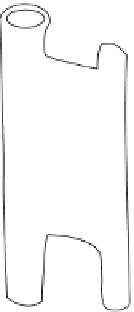Biomedical Engineering Reference
In-Depth Information
FIGURE 5.4
Venous valves determine the direc-
tion of blood within the venous system, preventing
blood flow back toward the capillaries. Skeletal mus-
cle contraction helps to transiently increase the pres-
sure within veins to propel blood toward the heart.
Arrows depict blood flow direction.
Vein
Venule
(
Figure 5.4
); the valves are uni-directional. As the blood evacuates one of the isolated
venous chambers (a section of vessel between two valves), the overall pressure of that por-
tion of the venous blood vessel is lowered, which facilitates blood flow into that section dur-
ing the next muscle contraction. This pumping action is efficient under normal conditions,
so that enough blood returns back to the heart and so there is not an excess of blood stored
in the venous system. As a side note, when the valves within the venous system do not
function properly, it is common for a person to develop varicose veins. Varicose veins are
characterized by an overall increase in the diameter of the veins which causes the valves to
not close properly. Therefore, under these conditions, blood can flow toward the capillaries
and then the hydrostatic pressure continually increases within the damaged venous section.
Skeletal muscle contraction cannot overcome this increased pressure under severe cases,
and therefore, blood begins to pool within the damaged venous section. Pooled blood
causes a distention of the vein beneath the skin, and this is what is seen as varicose veins.
5.3 BLOOD CELLS AND PLASMA
Blood is composed of two major components; the cellular component and the plasma
component (
Table 5.1
). In an average adult, the blood volume is approximately 5 L, of
which approximately 55% to 60% is plasma and the remaining portion is cellular. More
than 99% of the cellular component is composed of red blood cells. The most common
way to quantify the percent of blood that is cellular is by quantifying the packed red blood
cell volume, which is termed the hematocrit. Blood can be packed via centrifugation,
which forces the heavier cells to one location in a tube and the lighter fluid to a different



























Search WWH ::

Custom Search